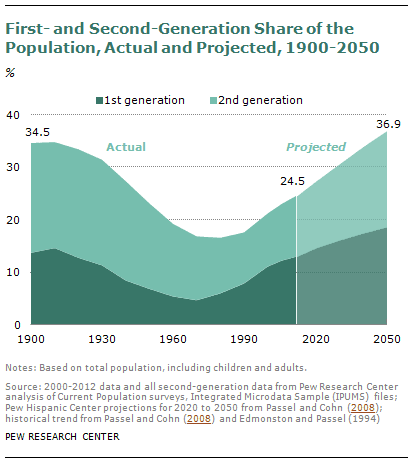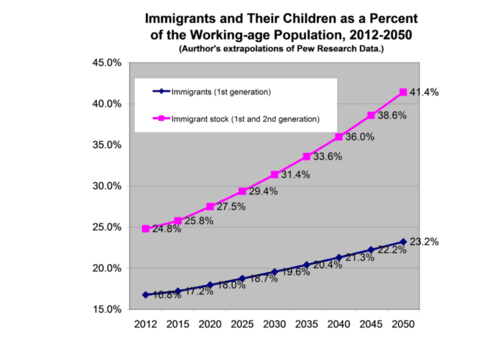

06/28/2016
For 12 years, VDARE.com has waged a lonely struggle to get it through the thick skulls of Main Stream Media commenters (and, more scandalously, professional economists) that the monthly job numbers issued by the federal government must be viewed in the context of renewed mass immigration. Occasionally, it looks like the message is getting through. But no-one at all pays attention to the fact that it’s now nearly fifty years since the 1965 Immigration Act kicked in, and the children of immigrants — who with immigrants are what demographers call the “immigrant stock” — are now also having an impact on the job prospects and wages of the Historic American Nation, the native-born Americans derived from the population already here in 1965. What follows is VDARE.com’s attempt to quantify that impact.The background: Paul Samuelson, the first American to win a Nobel Prize in economics, wrote shortly before enactment of the 1965 Immigration Act.
After World War I, laws were passed severely limiting immigration. Only a trickle of immigrants has been admitted since then…By keeping supply down, immigration policy tends to keep wages high. Let us underline this basic principle: Limitation in the supply of any grade of labor relative to all other productive factors can be expected to raise its wage rate; an increase in supply will, other things being equal, tend to depress wage rates.More than fifty years later it is clear that Samuelson was right: The post-1965 immigration surge coincided with increased income inequality and a fall in wages for most American workers. By contrast, the sharp immigration reductions in the 1920s ushered in a forty-year period during which ordinary workers got richer while the rich got relatively poorer.Economics [1964]
Harvard economist George Borjas has quantified the wage loss from post 1965 immigration. Among his research findings:
But what about the impact of second generation immigrants — U.S. born persons with at least one immigrant parent? They accounted for 8 per cent of the total working age population in 2012, according to the same Pew Research Center study. At 15.5 million, they were nearly half as large as the foreign-born population itself.
By 2050 the number of second generation immigrants will triple, to 46.4 million Second-generation immigrants will account for more than half the growth in U.S. working-age population between 2012 and 2050.
Pew Research projects that by 2050 41.4% of the U.S. working age population will be of “immigrant stock,” i.e., immigrants or children of immigrants. This will be the highest immigrant stock share in modern history.
| Working-age Immigrant Generations, 2012-2050 | |||
| (Millions of adults ages 18 to 64) | |||
| 2012 | 2050 proj. | % increase | |
| Immigrants (1st Generation) | 32.4 | 59.2 | 82.7% |
| 2nd Generation | 15.5 | 46.4 | 199.4% |
| Immigrant stock | 47.9 | 105.6 | 120.5% |
| 3rd+ generation | 145.3 | 149.4 | 2.8% |
| Working-age population | 193.2 | 255.0 | 32.0% |
| % of working-age population | |||
| Immigrants (1st Generation) | 16.8% | 23.2% | |
| 2nd Generation | 8.0% | 18.2% | |
| Immigrant stock | 24.8% | 41.4% | |
| Data source: Pew Research Center, Second-Generation Americans: A Portrait of the Adult Children of Immigrants, February 2013. Page 13. | |||
If Borjas’s native wage loss rule applies, the descendants of 1965’s Historical American Nation will face a reduction in wages due to the presence of 1st and 2nd generation immigrants of 14.5% in 2050, up from the 8.1% loss imposed by 1st generation immigrants only that year.

The long-term effects of immigration on American society may well depend less on the foreign-born than on their U.S.-born children. This from a research journal article on second-generation assimilation:
First generation immigrants have always been a flighty bunch, here today and gone tomorrow, in the society, but not yet of it. By contrast, their U.S.-born and reared children are, overwhelmingly, here to stay and, as citizens, fully entitled to ‘voice’ in the American political system…. Hence, the course of their adaptation will determine, to a greater extent than other factors, the long-term destiny of the ethnic groups spawned by today’s immigration. [The Adaptation of the Immigrant Second Generation in America: Theoretical Overview and Recent Evidence, Journal of Ethnic and Migration Studies, August 2009]At first glance, economic data seem to show the second-generation outperforming the first. Median household income of second-generation immigrants in 2012 is reported by Pew to be $58,100 versus $45,800 for the first generation; the corresponding homeownership rate advantage that year was 64% to 51%; poverty rate, 11% for the second-generation versus 18% for the first.
In no way, however, do these factoids support the assimilationist narrative of upward mobility between immigrant parents and their children. That is because many second generation are still not the children of today’s immigrants; many are the children of pre-1965 immigrants, now deceased. This explains why whites currently account for 46% of second generation adults and only 20% of the first, while Hispanics are 47% of the first and 35% of the second.
A true comparison of, say, household income between first and second generations would show today’s second generation income alongside that of their parents at a similar stage in life. Pew researchers claim such data is not available to them.
Equally important, the second generation advance reported by Pew may reflect gains made by a very different type of immigrant: Asians. This may have effectively masked continued deterioration among second-generation Hispanics. I present evidence for this in an article on California in which I reported “…. a widening gap in the academic, economic, and linguistic achievement of second- and even third- generation Latinos and the overall population.”
VDARE.com Editor Peter Brimelow’s 1995 book Alien Nation was subtitled Common Sense About America’s Immigration Disaster. This analysis demonstrates that the post-1965 influx has been even more of a disaster for American workers than is generally realized.
Edwin S. Rubenstein is President of ESR Research Economic Consultants.
This is a content archive of VDARE.com, which Letitia James forced off of the Internet using lawfare.